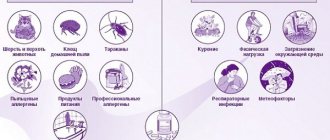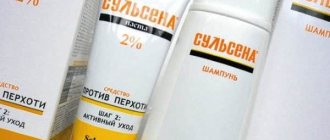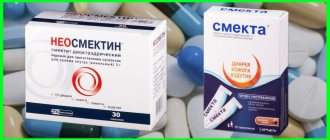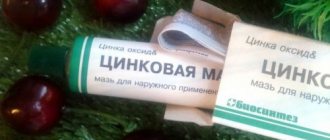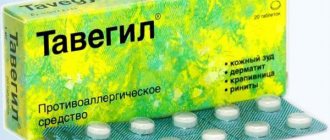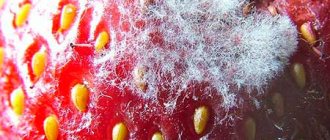An allergy inhaler is used for seasonal runny nose, bronchospasm due to obstructive bronchitis, bronchial asthma, and for the treatment of cough in allergic (eosinophilic) alveolitis. For these diseases, it is best to use a MESH inhaler, since it is easy to have with you at all times, it quickly restores normal breathing, and helps with asthma attacks.
For treatment at home, a compressor nebulizer is often chosen; it is more versatile than an ultrasonic one.
For spraying, prepare solutions with drugs that facilitate the removal of mucus (for example, Lazolvan), reduce the formation of mucus (Atrovent), relieve inflammation (Pulmicort), dilute sputum (Fluimucil), dilate the bronchi (Berodual). The first inhalation for allergies should be with half the dose, since individual intolerance is possible (cough, sore throat, worsening breathing), requiring a change in the drug.
To cleanse the respiratory tract, use saline solution, soda (Sodium bicarbonate), and alkaline mineral waters. They are safe, suitable for pregnant women and children, moisturize and reduce swelling.
When do you need an allergy inhaler?
An allergy inhaler is needed to treat:
- allergic rhinitis (seasonal runny nose);
- bronchitis with bronchospasm;
- bronchial asthma;
- eosinophilic alveolitis (damage to the alveoli of the lungs).
Its advantages over conventional aerosol preparations (spray or metered aerosol in a can) are:
- the possibility of additional moisturizing of the mucous membrane and cleansing of the respiratory tract;
- uniform distribution of the drug over the entire surface and settling of solution droplets with a long-lasting effect on the mucous membrane;
- a precisely measured dose of the drug, you can administer a large amount of the drug at once to relieve a severe attack of suffocation;
- ease of use;
- you can conduct treatment sessions with medications and preventive courses with saline solutions;
- selecting a spray mode that allows you to deliver the solution to the affected area;
- suitable for children and weakened patients;
- no need to adjust your breathing to the spray;
- the composition that fills the inhaler does not contain freon and other additional components that increase allergies.
If we compare inhalation and oral administration of medications, then with the inhalation route of entry the maximum amount of the drug remains in the respiratory tract. This helps to avoid drug load on the liver, kidneys, and circulatory system. For allergy sufferers, it is also important to have less impact on the general state of the immune system and mechanical removal of the allergen, this facilitates the course of the disease.
Using an inhaler, you can very quickly relieve spasm and swelling of the bronchi, which is comparable to intravenous administration of the drug.
Types of devices
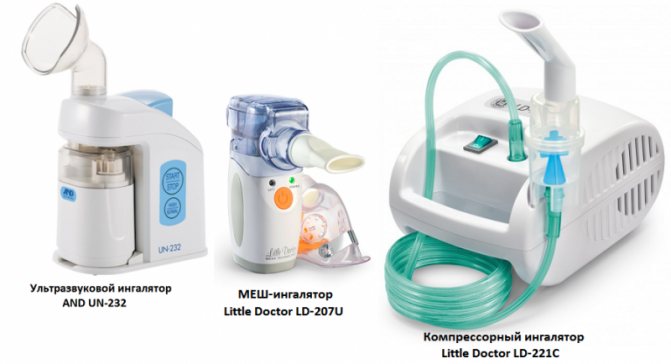
Several types of devices are used to treat allergies:
- compressor inhalers - convert the solution into an aerosol with small particles by pumping air with a compressor, universal;
- ultrasonic – a flow of droplets is created using ultrasound, silent;
- MESH inhalers - combine vibrations of an electronic mesh membrane with ultrasonic waves, compact.
Recommendations for selection
To select an inhaler for the treatment of allergies, take into account that compressor devices can be refilled with all types of medications, they are durable, and can be used by the whole family. The disadvantages include the fact that almost all devices require connection to an electrical outlet, they are quite bulky, suitable only for home treatment (cannot be taken with you), and are noisy.
An ultrasonic nebulizer is distinguished by its silent operation, high nebulization speed, and helps to use medicine economically. There are portable models, but hormones, antibiotics, and a number of biologically active drugs cannot be sprayed through them.
MESH inhalers are the most convenient; you can always have them with you, which is important for patients at risk of developing an attack of suffocation. Such devices are universal, suitable for all types of solutions, used in sitting and lying positions, operation is not accompanied by noise. The only disadvantage is the higher price - they cost 1.5-2 times more than compressor or ultrasonic ones.
When purchasing an inhaler for allergy sufferers, you should also pay attention to:
- brand of device (trusted manufacturers include Omron, Microlife, Little Doctor, Rotor);
- the size of aerosol droplets when sprayed is for allergic rhinitis from 5 microns, for bronchospasm 3-5 microns, patients with allergic alveolitis need a grinding mode of up to 0.5-3 microns;
- possibility of changing the operating mode;
- the capacity of the nebulizer chamber (liquid is poured into it) and the residual volume (the smaller it is, the lower the consumption of the medicine);
- shape – for a small child it is better to choose a nebulizer in the form of a toy;
- equipment - for the treatment of a runny nose, nasal cannulas are needed, a mask is selected according to size for a newborn and a child, a mouthpiece is required for the treatment of asthma and pulmonary pathology.
Kinds
Inhalers are classified as follows:
- compressor This option is the most optimal and versatile, as it is capable of spraying almost all medications.
It is also quite a convenient type for inhalation with mineral water. Saline solution reduces swelling and also promotes mucus discharge. The only thing is that such nebulizers are heavy and can also significantly reduce the temperature of the solution, which can affect its properties; - steam. Unlike the first option, this type can only diffuse essential oils.
If the temperature of the ether exceeds degrees, it simply evaporates. The concentration of the substance is not high, so the therapeutic effect will be correspondingly less. It is also impossible to accurately calculate the dosage of a substance on your own at home. However, the price of this nebulizer will greatly surprise you; - ultrasonic. These inhalers are relatively lightweight, silent and come with batteries. It should be remembered that ultrasound destroys antibiotics, mucolytics, and hormonal drugs.

The pricing policy is rather high due to the need to purchase consumables;
- mesh nebulizers. Here the cost is directly proportional to the high quality. They can be said to have taken on all the advantages of the previous types. But it is strictly forbidden for them to inhale herbal decoctions, euphilin, oil solutions and hormonal preparations.
Also, according to the supply of aerosol, nebulizers are divided:
- those that are activated by breathing. Its peculiarity is that the aerosol output is greatly reduced during exhalation;
- on manual control. Although there is no aerosol loss during exhalation, as in the first case, you still need to get used to such an inhaler and learn to breathe correctly;
- not activated by breathing.
Find out how to use mumiyo for allergies. What are the indications for using Prevalin for allergies? The answer is here.Why do you need a non-hormonal ointment for allergies? Click go.
Inhalations for allergic cough

For allergic cough, drugs from the following groups are needed for inhalation:
- local hormonal agents – Pulmicort, Flixotide;
- dilating bronchi - Berodual, Ventolin;
- thinning viscous sputum - Ambrobene, Fluimucil;
- mast cell membrane stabilizers – Cromohexal, Cromoglin.
The result of treatment is the cleansing of the respiratory tract, easier breathing after the expansion of the bronchial branches, a decrease in the production of sputum and easier elimination.
Attacks of suffocation and hacking cough occur less frequently and occur in a milder form. This helps you feel better and reduce your dose of emergency medications that can harm your heart. Patients' exercise tolerance increases. Inhalation therapy for allergic cough is more effective than tablets and injections, and its side effects are less pronounced.
Review of the best inhaler models
The best nebulizer models are:
OMRON CompAIR C28
This is the best device among compressor inhalers, which is in particular demand among the population. Its advantages include ease of use, fine grinding of the drug, as well as high power of the device.
When using OMRON, it is permissible to use antibiotics, mineral water, almost all drugs belonging to different groups, as well as physical solution. Medicines will penetrate into the patient’s body using dry steam, which will allow it to be evenly distributed throughout all parts of the respiratory system.

Microlife NEB-50
Another compressor type of nebulizer, which is highly rated by doctors. The operating time of the unit is at least 1 hour. When heated, the device turns off automatically.
The advantages include a continuous supply of medicine, which is necessary for the treatment of serious diseases. The device can be used by patients of any age, since the nebulizer has several attachments in stock. The only downside is the big noise when carrying out home treatment.

AND UN-232
This is a modern ultrasonic inhaler, the main feature of which is the presence of a heating program. Thanks to this, it is possible to cure diseases of the respiratory system, throat and runny nose. Each device mode has its own indicator light.
The only disadvantage of the device is the large size of the nebulizer. Judging by the reviews, the treatment is convenient for patients of any age.
When choosing an inhaler model, it is imperative to familiarize yourself with the classification of devices - only after this will the patient be able to choose the right device for home therapy.
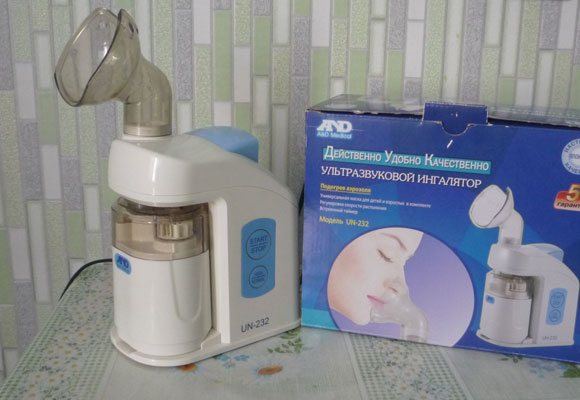
When you can’t use inhalations if you have allergies
Inhalations for allergies cannot be carried out if there is an admixture of blood in the sputum and pus is coughed up. Contraindications for the procedures include severe heart failure, rhythm disturbances, hypertension (pressure above 140/90 mmHg), and deterioration of cerebral circulation. It is prohibited to use a nebulizer at elevated body temperature, complications of respiratory tract diseases:
- pneumothorax (air entering the chest);
- emphysema (increased airiness of the lungs);
- bronchiectasis (irreversible dilatation of the bronchi) in the acute stage.
If the drug is used for the first time, it is recommended to take half the dose for the first inhalation. If inhalation worsens the cough or makes it harder to breathe, then further treatment is dangerous. You need to see a doctor to correct the treatment.
Allergies and causes of their occurrence
Allergy is a natural reaction of the human body, which makes itself felt when certain factors act on the immune system.
This reaction develops due to the body’s too high sensitivity; as a result, when any foreign substance enters the respiratory or digestive organs, the immune system immediately begins to signal this, creating unpleasant allergy symptoms in the person.
If the immune system works normally, the body will calmly react to the entry of a new unknown component into it, while producing protective antibodies. However, if there is a malfunction in the functioning of the immune system, the production of beneficial antibodies stops.
Regardless of the type of allergen that led to the development of the disease, doctors identify a list of reasons that most often cause this disease:
- Weak immunity. If the body of a child or adult is often exposed to a certain disease that can weaken the immune system, this can lead to the development of allergies. In addition, a weak immune system begins to be observed in a person over time if he is often sick or leads an unhealthy lifestyle.
- Improper functioning of the gastrointestinal tract. If the human body is unable to properly digest the beneficial substances that enter it, this can also become a significant reason for the development of an allergic reaction. As you know, the digestive organs must digest any allergens and convert them into amino acids, but if this does not happen, a person experiences the development of allergies as a result of the penetration of harmful substances into the bloodstream.
- Liver dysfunction. If an organ does not work at full capacity, as it should, this poses a significant danger to the patient’s health.
- Kidney failure. As a result of the development of the disease, the paired organ begins to work in a weakened and incorrect mode. This causes serious problems with the functioning of the excretory system.
These reasons are considered the main reasons why a person may develop an allergic reaction. However, most often the disease develops as a result of penetration of a foreign body into the respiratory organs, which leads to the appearance of unpleasant and dangerous symptoms.
To get rid of them, an allergy inhaler is prescribed, which is capable of delivering medicine deep into the lungs, quickly normalizing the patient’s condition.
Recipes for the procedure
The most commonly used recipes for preparing a solution for allergies are those containing Lazolvan, Sodium bicarbonate, Fluimucil, Cromohexal, Pulmicort.
Lazolvan
At one time, a child under 6 years old takes 1-2 ml, and at an older age and an adult, 3-4 ml is consumed. To spray through a nebulizer, you only need Lazolvan solution for inhalation; it is available in 100 ml bottles (syrup is not suitable). The drug is diluted with saline in a ratio of 1:1, 2-3 procedures are carried out per day for 7-10 days.
Sodium bicarbonate
A sterile solution of Sodium bicarbonate 4% will require 2-3 ml at a time and the same amount of physiological solution will be added. Instead of this composition, for allergic rhinitis and obstructive bronchitis, asthma, alkaline mineral water without gas (Narzan, Essentuki) 3 ml per session can be used. From 2 to 4 inhalations are carried out per day, the course of treatment is long, and continues until the condition improves steadily.
Fluimucil
The drug in the form of a 10% solution in ampoules is mixed with saline in a glass container, since when interacting with glass and rubber, hydrogen sulfide is released, which is dangerous for allergy sufferers. At one time you will need 3 ml for an adult and 1-2 ml for a child over 2 years old, an equal amount of solvent is added to them.
Fluimucil is used with caution for bronchial asthma; a trial procedure is required due to the risk of bronchospasm. 1-2 procedures are prescribed per day, usually the course does not exceed 7 days.
Cromohexal
For one inhalation, an adult and a child over 5 years old will need 2 ml of solution and 2 ml of saline solution. The mixture is prepared immediately before the procedure; the finished composition cannot be stored. For allergies, Cromohexal is used in cycles of 4-6 weeks, since the effect of its administration is not felt immediately. You need to do 4 sessions a day at equal intervals. After improvement, it is important to gradually reduce the dose to prevent exacerbation.
Pulmicort
To spray through a nebulizer, you must purchase Pulmicort in plastic containers (nebulas). There are 2 dosages on sale: 0.25 and 0.5 mcg/ml. For a child under 12 years of age, 0.25-0.5 mcg is taken per inhalation, and from 12 years of age, adults need 1-2 mg.
Nebulas can be used in their pure form, but the volume of liquid that remains in the device should be taken into account. Therefore, it is recommended to add 1-2 ml of saline solution, most often the total amount is adjusted to 3-4 ml. 2-4 procedures are prescribed per day; withdrawal for bronchospasm is carried out gradually after the patient’s condition improves and tests and respiratory function indicators normalize.
For allergic rhinitis, Pulmicort is usually used for no more than 5-7 days. A gradual reduction in dosage is necessary.
Berodual
Berodual is dosed in drops - 10-20 for children and 20-40 drops for adults per 3 ml of saline solution. 3-4 procedures are prescribed per day, the course of treatment is determined individually taking into account the diagnosis and other prescriptions. The drug can be used independently or for preparatory inhalation. It is used 15 minutes before inhaling hormones or cough suppressants for deeper penetration.
Berodual is needed to dilate the bronchi during their spasm due to exacerbation of bronchitis with an allergic component, chronic obstructive pulmonary disease, and bronchial asthma. The course of treatment continues until breathing improves.
Recognizing and treating inhalant allergies
Many substances in the air surrounding a child are not indifferent to his respiratory tract, and the body reacts to them with manifestations that we call allergies. The struggle that occurs when an allergen enters the body is similar to the struggle described in the section on food allergies. Sneezing, wheezing, nasal discharge and itching often make life difficult for a child with allergies. It's good that his parents can help him.
How to determine if your baby is susceptible to allergies?
All the usual signs of allergies are also characteristic of inhalant allergies. Inhalation allergies are seasonal. The most common signs and symptoms that children experience are: clear nasal discharge and watery eyes frequent sneezing bouts of constant sniffing nosebleeds a transverse crease at the tip of the nose from constantly blowing the nose dark circles under the eyes frequent colds and/or ear infections coughing at night and congestion nose in the morning, noisy breathing at night, cough during exercise, lingering cough, often rattling and whistling
Recognizing allergies in a child
First, decide to what extent your baby's allergies are a serious problem. Is this a temporary inconvenience that can be eliminated, or does the allergy interfere with the normal growth, development and behavior of the baby? Try to find out which allergens are most likely to cause allergic reactions in your child. Here are the most common allergic conditions and tips on what to do if they occur.
Hay fever
. Suspect this type of allergy. If a child’s allergies are seasonal, occurring during times of increased concentration of plant pollen in the air, on windy days, most likely he has this type of allergy. If you think your allergies are caused by pollen, try the following steps: Keep your child indoors on windy days when plants are blooming and pollen is spreading. Avoid visiting areas with the highest concentrations of pollen (for example, fields and meadows) during flowering. Keep windows closed, especially in your child's bedroom. To remove pollen, bathe your baby and wash his hair before bed; shake pollen out of clothes. If allergies are severe, try installing air conditioning and air-filtering devices in the bedroom, or better yet, throughout the house. Do not hang clothes and bedding outside the house - pollen and animal dander settle on them.
Animal danger
. The next object of your suspicion is your dog, cat, bird or your neighbors' pet. When your child plays with a pet, does he or she experience sneezing, runny nose, or wheezing? If a dog is suspected, you have to make a choice: it or the child (at least, expel it from the baby’s bedroom). It is commonly believed that allergies are caused by animal fur, although in reality it is caused by dander. Often, a child on the street can communicate with an animal that causes him an allergy without any unpleasant consequences, but as soon as he moves his games into the house, he immediately begins to sneeze. We repeat that the need to part with a pet depends entirely on how severe the child’s allergy to it is. If other members of your family have persistent allergies, it would be prudent to allow your baby to interact with it at home before purchasing a pet. All cats and dogs have the potential for allergenicity, but some breeds are more so. If you have a lot of allergy sufferers in your family, it is best to buy a goldfish.
Mold
. Plant spores that grow in dark, cool, damp places are called mildew or downy mildew. Mold can be found in closets, the attic, pieces of wallpaper, old mattresses, pillows and blankets, baskets, damp carpet, trash cans, shower curtains, bathroom shelves, toilet tiles (especially in damp corners) and on house plants. An often overlooked source of mold in bedrooms is the humidifier (see section on vaporizers and humidifiers). Outside the house, sources of mold are heaps of damp, last year’s grass, fallen leaves, and woodpiles of firewood.
To eliminate mold in your child's bedroom and play areas, you need to do the following: Ventilate and clean all favorite spots for mold to appear. Use (keep it away from your child!) a mold-killing disinfectant, such as bleach, when cleaning. Close windows adjacent to bushes that may harbor mold or pollen accumulation. Clear the yard of wet accumulations of firewood and trim the bushes. Remove carpets and pieces of wallpaper that have become damp from water leaks. If you use a humidifier while the central heating is on, mold may appear on the wallpaper or curtains; in this case, change the wallpaper and have the curtains cleaned more often.
Dust
. Dust allergens are tiny insects called dust mites. They look like microscopic crumbs and live in dust on carpets, bedspreads and furniture upholstery. Thriving in warm, damp conditions, they feed on the scales of constantly renewed human skin. Ticks secrete tiny balls that float in the air and enter the human respiratory tract with it. It is the mite excrement that provokes allergies, not dust or mites as such. However, eliminating dust helps combat these allergens. Carpets can be cleaned with akarosan - a powder that kills dust mites and neutralizes their allergenic secretions; then they can be removed with a vacuum cleaner.
A house completely free of dust is as unlikely as a baby’s nose being constantly clean. However, you can try to reduce the amount of dust in your child's environment. And I remind you once again that the intensity of your fight against dust depends on the severity of the child’s allergies. Start in the bedroom if your child breathes noisily at night and wakes up with a stuffy nose.
Allergy medications
Decongestants, antihistamines and their combinations are used mainly for older children, but some types are also suitable for children. Follow the same precautions as when taking cold medications. It is best to use tips for maintaining nasal hygiene and thinning secretions. Based on the severity of your child's allergies, your doctor or allergist will advise you on safe and effective treatment.
How to free your bedroom from allergens
Bed sheets
Place mattresses, box springs and pillows in thick, allergy-resistant, zippered covers. Cover the zippers with tape. Do not use down or feather pillows. Also avoid pillows filled with rubber foam (they can grow mold if they get wet). Buy allergen-resistant pillows and covers made from polyester materials. Remove furry toys from the child’s crib, and if the child has severe allergies, it is better to take them out of the bedroom altogether. Pack them in a bag and take them to the garage. If your child has a favorite stuffed toy, wash it often. Swap out wool mattresses and pajamas for synthetic or cotton ones and wash more often. Air and vacuum the mattress, blankets and other bedding at least once every 2 weeks. Do not store items under beds that may accumulate dust. Move the crib away from open windows and fans.
Bedroom furniture
Replace fabric chairs with plastic, wooden or canvas ones. For wood and linoleum floors, use rugs and wash them frequently. If you can, avoid soft-pile carpets. Do not use ornate furniture, where dust may accumulate in the decorative recesses. Don't keep books or bookshelves in your bedroom—they're known dust collectors. Don't turn your bedroom into a storage area. Don't throw things around the room, keep clothes in closets and lock closets. Instead of dust-collecting blinds, use roll-up window mats. If possible, use washable cotton curtains rather than curtains. Check whether the material from which the furniture is made causes allergies. In the manufacture of beds and other furniture, a strong allergen such as formaldehyde can be used. Check with the manufacturer.
Ventilation and air purification
Keep bedroom doors closed and keep pets away During flowering season, keep windows closed All vents should be covered with a filter or gauze, or sealed completely for the time being Avoid electric fans - they collect dust and cause it to circulate Buy an air filter The best ones are labeled HEPA (special high efficiency battery) means they can remove dust mite excrement, pollen, mold, spores, pet dander and many other irritants. The cost of an air purifier may be covered by your insurance company if you have a doctor's prescription.
Cleaning Tips
Do not use a vacuum cleaner in the presence of a child, as vacuum cleaners raise dust. After cleaning, ventilate the room. Use vacuum cleaners with dust containers and water filters to prevent dust from returning to the room and releasing mites, and vacuum cleaners with a HEPA filter, which suck up and retain invisible allergens from dust. Wet cleaning is better than dry cleaning Wipe floors with a mold-killing disinfectant, such as bleach Remove smokers from your home Beware of other allergens and irritants in the air Cooking odors, deodorants, air fresheners, fireplace smoke, house odors, perfumes, talcum powder, cosmetics products, naphthalene and insecticides.
All of the above work to eliminate allergens from the home rarely has to be done in full. However, if your child has severe allergies, it is better to follow all the recommendations given. You can learn more about how to recognize and treat allergies in your baby from your doctor or pediatric allergist.
To contents | To the beginning of the section | To the beginning of the chapter To the previous topic | On to the next topic
Features of inhalation for allergic cough with a nebulizer for a child
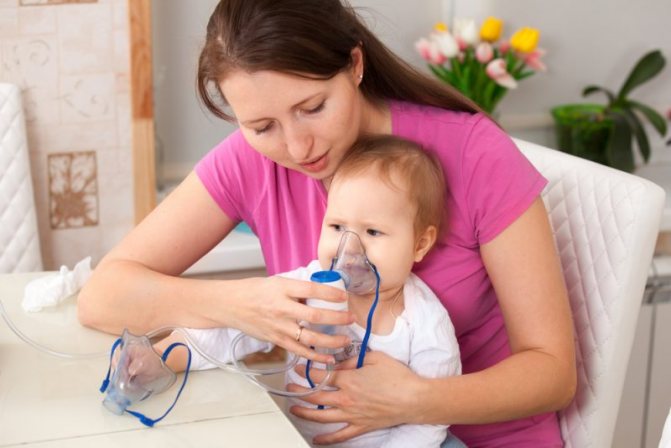
When treating allergic cough in children, inhalation through a nebulizer is carried out using a mouthpiece, and for a small child a special size mask is needed. Before the first procedure, it is necessary to explain the principle of treatment; it is better for young children to do this in a playful way. The noise from the compressor inhaler can cause fear and crying, so it is important to discuss everything with the child in advance. The session takes place only in a completely calm state, supervised by an adult.
An hour before the procedure, you need to feed the child, give him warm water to drink 15 minutes, and measure the temperature. After inhalation, you need physical and emotional rest for at least an hour; it is better to turn on your favorite cartoons and read a book during this time. It is recommended to avoid active games, talking, eating and eating. During the cold season, you should not go outside for at least 2-3 hours.
Instructions for inhalation procedures
To relieve unpleasant symptoms quickly and effectively, you need to follow a number of rules:
- First of all, the patient needs to sit comfortably and place the device on a flat surface. All foreign objects (for example, chewing gum) should be removed from the mouth.
- Depending on the type of inhalation, it is necessary to use a mouthpiece or a special nozzle for the nose. After the procedure, they must be washed with warm water (preferably using a soap solution), which will help get rid of bacteria accumulated on its parts.
- The aerosol solution should only be prepared under sterile conditions. Medicines must be diluted with sodium chloride (0.9%). But using water (even boiled) is prohibited.
- You need to breathe the inhalation solution for 5-10 minutes.
- It is permissible to do 1-3 procedures per day, which depends on age and type of disease (atopic dermatitis, nasal edema, and so on). Treatment for children is carried out faster than therapy for an adult.
- The course lasts on average 7 days.
Nebulizer treatment must be carried out strictly according to the instructions:
- first of all, you need to check the functioning of the device - to do this, you need to spray a stream of the drug upward and understand how strong and uniform it is,
- then you need to dilute the drug according to the doctor’s prescription and pour it into the inhaler,
- after this, the procedure is carried out strictly according to the instructions and recommendations of the doctor - first you need to set up the device, then exhale and sharply inhale the drug.
Precautions and side effects
Precautions include:
- It is important to install the nebulizer on a flat surface,
- To avoid overheating, you need to make sure that the air collector is open,
- Children should undergo inhalation under the supervision of their parents,
- after home therapy, the device should be disconnected from the network,
- It is forbidden to independently invent medicinal mixtures for use by inhalation,
- It is forbidden to rinse the device under running water - first you should disassemble the unit, and then rinse all the parts one by one,
- At temperatures above 37 degrees, inhaling the medicine is prohibited.
Before starting treatment, you must consult your doctor.
Will saline inhalation help with allergies?
Inhalation of saline solution for allergies helps:
- relieve swelling and nasal congestion;
- moisturize the mucous membrane of the respiratory tract throughout;
- reduce the thickness of sputum and facilitate its removal;
- cleanse the nasal passages and bronchial branches from allergens;
- eliminate dryness, soreness and irritation of the throat, soften superficial cough.
The saline solution has a high degree of safety, but it itself has only a symptomatic effect - it alleviates the condition during the procedure, but does not have an active effect on the course of the disease.
Efficiency
Doctors often recommend using a nebulizer during allergic reactions. There are several good reasons for this.
| 1 | Smaller doses of drugs are required to achieve an effect. |
| 2 | The action comes faster than from potions and tablets. |
| 3 | Minimal side effects. |
| 4 | This is a painless method, the mucous membrane is not damaged. |
| 5 | The procedure can be performed on patients of almost any age. |
Do not doubt whether inhalations can be done if you have allergies. During the procedure, the medicine penetrates deep into the respiratory system. It affects the immune system, swelling of the mucous membrane subsides, microcirculation is restored. Regular use helps to shorten the exacerbation phase, it is less acute, and the amount of medications used is reduced.
What other medications can be refilled

For allergic diseases, in addition to the main medications, the doctor also prescribes:
- antibacterial - Furacilin, Chlorhexidine;
- immunomodulator Derinat;
- combined – Fluimucil-antibiotic;
- sea water - Linakva, Sialor.
For allergies, the inhaler is filled with solutions with anti-inflammatory and anti-allergic effects that thin sputum and mucus from the nose and facilitate its removal. It is best to use a MESH inhaler or compressor device.
Solutions for inhalation
Internal solutions for the treatment of respiratory organs can be different.
Herbal decoctions
For this recipe you can use sage, raspberry leaves, chamomile, thyme, oregano and eucalyptus. Throw a spoonful of herbs into a liter of boiling water and keep on fire for 10 minutes. After this, leave the mixture to brew for half an hour. The medicinal liquid should be used warm.
Salt
Saline solutions involve treatment using saline, liquid with sea salt, or using any alkaline mineral water (for example, Essentuki or Borjomi). During pregnancy or childhood, you need to wait until the gases are completely released from the mineral water.
With medications
It is permissible to pour into the nebulizer:
- antihistamines,
- corticosteroids,
- Cromons,
- mucolytics,
- bronchodilators,
- hormonal drugs (for example, Pulmicort).
The choice of treatment depends on how the disease manifests itself.
Which inhalers are better
It is difficult to answer this question, since the approach must be strictly individual. Only a doctor, after a complete examination of the patient, can determine which drug and in what form will be effective. The best inhaler for asthma is the one that quickly stops an attack, does not cause side effects and is easy to use. Which of them are the most common?
- Symbicort Turbuhaler contains budesonide and formoterol. Both of these substances have a rapid effect, have an anti-inflammatory effect and are well tolerated. This asthma inhaler is a powder inhaler with a strict dosage of the drug.
- Salbutamol is suitable for both adults and children. It acts quickly and rarely causes side effects.
Rules for rinsing the nose for adults
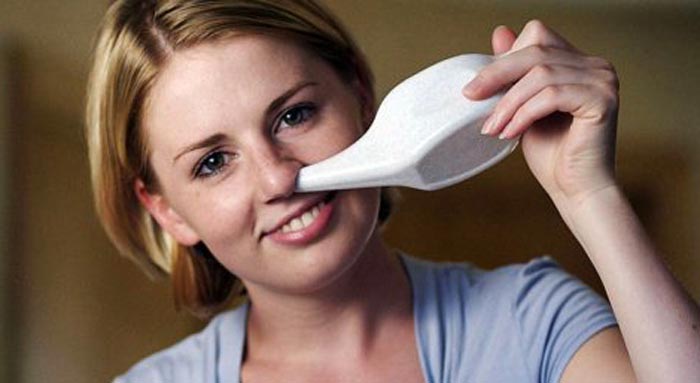
Before the procedure, it is important to learn the inhalation technique to avoid medication entering the Eustachian tube. Careless manipulations can lead to inflammation of the middle ear.
Washing at home is carried out in three ways:
- The patient needs to bend over the container with his mouth open and tongue hanging out. Then inject the medicine into the nasal opening, gradually increasing the force of the stream. In this case, the solution should flow out of the mouth.
- Lean over the container (for convenience, it is better to use a sink), tilting your head to the side. Then pour the medicine into the nostril located above in a thin stream and let it flow out from the bottom. Breathing should be deep and even. Then tilt your head to the other side and repeat the procedure. Each nasal passage is washed 4 to 5 times in turn.
- Clean your nose “from the palm of your hand”: pour the solution, suck it in with one nostril and blow your nose with the other.
There are also a number of rules, compliance with which will make the procedure more comfortable and effective. First, you need to listen to all the doctor’s recommendations. If a specialist prescribes a specific drug and the method of its administration, then there are good reasons for this.
Secondly, inhalation should be carried out 1.5 - 2 hours after eating. After the procedure, you should not eat, drink or smoke for 1 hour.
Thirdly, washing should be done in the most comfortable clothing and body position. Extraneous factors should not cause discomfort or distract from the process.
How to choose the right inhaler
After examining the patient, the doctor prescribes a medicine that is designed to help prevent and relieve attacks. When choosing an inhaler, you need to focus on the doctor’s recommendations. But when buying, you should also pay attention to the following characteristics:
- the inhaler should be easy to use, preferably a pocket-sized one;
- it is very important that it is easy to use. Then the patient, even during an attack, will be able to help himself;
- It is best if the inhaler has the ability to dose the drug;
- price also affects the choice of inhaler. This item is an essential item for an asthma patient and needs to be purchased frequently.
Description and methods of application
Chlorine and sodium ions are usually found in non-cellular fluid and enter the body with food. Sometimes there are situations of deficiency of these components due to fluid loss during illness.
Intravenous sodium chloride solution is used:
- With loss of body fluid after vomiting, indigestion.
- To remove toxins.
- For constipation (in the form of an enema).
- For washing purulent wounds.
- For eye inflammation.
- For inhalation and rinsing of nasal mucous membranes.
This therapy helps restore the body after pathological conditions and get rid of allergic manifestations.
How to use a pocket inhaler correctly
- remove the cap from the can;
- turn it upside down;
- the thumb should be located at the bottom, and the middle or index finger should be at the bottom of the can;
- shake well, and in some types of inhalers you need to turn the disk back and forth several times;
- exhale;
- bring the inhaler to your mouth and tightly clasp the mouthpiece with your lips;
- take a deep breath through your mouth while simultaneously pressing the bottom of the can;
- hold your breath for 5 seconds and remove the inhaler from your mouth;
- exhale slowly.
After a minute, you can inject a second dose of the drug if necessary.
Indications for use
The use of inhalers is recommended in case of allergic diseases of the upper respiratory tract, which include:
- allergic rhinitis;
- tracheitis;
- pharyngitis;
- bronchial asthma.
The main indicator for the use of inhalers is the occurrence of an allergic disease directly in the upper respiratory tract.
Since during inhalation therapy the drug used directly enters the site of inflammation, I act on the surface of the mucous membrane of the respiratory tract in the most gentle way possible.
Treatment of a child
From the age of three, children can use an inhaler. Usually this does not cause negative emotions in the child, which cannot be said about injections. For more accurate dosing of the drug, it is recommended that young children use a spacer, which, using a special valve, delivers the medicine only when inhaling. Later you can do without it. What inhalers for bronchial asthma are used for children? It is best to use powdered ones, as they are easier to dose. In this regard, Symbicort Turbuhaler is quite convenient and safe.



